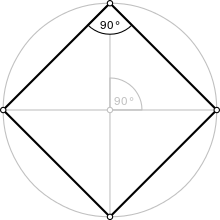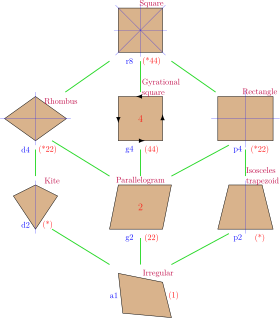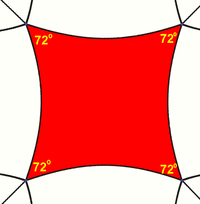Square
| Square | |
|---|---|
 A regular quadrilateral | |
| Type | Regular polygon |
| Edges and vertices | 4 |
| Schläfli symbol | {4} |
| Coxeter–Dynkin diagrams | |
| Symmetry group | Dihedral (D4), order 2×4 |
| Internal angle (degrees) | 90° |
| Properties | Convex, cyclic, equilateral, isogonal, isotoxal |
| Dual polygon | Self |
In Euclidean geometry, a square is a regular quadrilateral, which means that it has four straight sides of equal length and four equal angles (90-degree angles, π/2 radian angles, or right angles). It can also be defined as a rectangle with two equal-length adjacent sides. It is the only regular polygon whose internal angle, central angle, and external angle are all equal (90°). A square with vertices ABCD would be denoted ABCD.[1]
Characterizations
[edit]A quadrilateral is a square if and only if it is any one of the following:[2][3]
- A rectangle with two adjacent equal sides
- A rhombus with a right vertex angle
- A rhombus with all angles equal
- A parallelogram with one right vertex angle and two adjacent equal sides
- A quadrilateral with four equal sides and four right angles
- A quadrilateral where the diagonals are equal, and are the perpendicular bisectors of each other (i.e., a rhombus with equal diagonals)
- A convex quadrilateral with successive sides a, b, c, d whose area is [4]: Corollary 15
Properties
[edit]A square is a special case of a rhombus (equal sides, opposite equal angles), a kite (two pairs of adjacent equal sides), a trapezoid (one pair of opposite sides parallel), a parallelogram (all opposite sides parallel), a quadrilateral or tetragon (four-sided polygon), and a rectangle (opposite sides equal, right-angles), and therefore has all the properties of all these shapes, namely:[5]
- All four internal angles of a square are equal (each being 360°/4 = 90°, a right angle).
- The central angle of a square is equal to 90° (360°/4).
- The external angle of a square is equal to 90°.
- The diagonals of a square are equal and bisect each other, meeting at 90°.
- The diagonal of a square bisects its internal angle, forming adjacent angles of 45°.
- All four sides of a square are equal.
- Opposite sides of a square are parallel.
A square has Schläfli symbol {4}. A truncated square, t{4}, is an octagon, {8}. An alternated square, h{4}, is a digon, {2}. The square is the two-dimensional case of two families of regular polytopes, the hypercubes and cross polytopes.
Perimeter and area
[edit]
The perimeter of a square whose four sides have length is
and the area A is
Since four squared equals sixteen, a four by four square has an area equal to its perimeter. The only other quadrilateral with such a property is that of a three by six rectangle.
In classical times, the second power was described in terms of the area of a square, as in the above formula. This led to the use of the term square to mean raising to the second power.
The area can also be calculated using the diagonal d according to
In terms of the inradius r, the area of the square is
hence the area of the inscribed circle is of that of the square.
Because it is a regular polygon, a square is the quadrilateral of least perimeter enclosing a given area. Dually, a square is the quadrilateral containing the largest area within a given perimeter.[6] Indeed, if A and P are the area and perimeter enclosed by a quadrilateral, then the following isoperimetric inequality holds:
with equality if and only if the quadrilateral is a square.
Other facts
[edit]- The diagonals of a square are (about 1.414) times the length of a side of the square. This value, known as the square root of 2 or Pythagoras' constant,[1] was the first number proven to be irrational.
- A square can also be defined as a parallelogram with equal diagonals that bisect the angles.
- If a figure is both a rectangle (right angles) and a rhombus (equal edge lengths), then it is a square.
- A square tiling is one of three regular tilings of the plane (the others are the equilateral triangle and the regular hexagon).
- The square is a highly symmetric object. There are four lines of reflectional symmetry and it has rotational symmetry of order 4 (through 90°, 180° and 270°). Its symmetry group is the dihedral group D4.
- If the inscribed circle of a square ABCD has tangency points E on AB, F on BC, G on CD, and H on DA, then for any point P on the inscribed circle,[7]
- If is the distance from an arbitrary point in the plane to the i-th vertex of a square and is the circumradius of the square, then[8]
- If and are the distances from an arbitrary point in the plane to the centroid of the square and its four vertices respectively, then [9]
- and
- where is the circumradius of the square.
Coordinates and equations
[edit]
The coordinates for the vertices of a square with vertical and horizontal sides, centered at the origin and with side length 2 are (±1, ±1), while the interior of this square consists of all points (xi, yi) with −1 < xi < 1 and −1 < yi < 1. The equation
specifies the boundary of this square. This equation means "x2 or y2, whichever is larger, equals 1." The circumradius of this square (the radius of a circle drawn through the square's vertices) is half the square's diagonal, and is equal to Then the circumcircle has the equation
Alternatively the equation
can also be used to describe the boundary of a square with center coordinates (a, b), and a horizontal or vertical radius of r. The square is therefore the shape of a topological ball according to the L1 distance metric.
Construction
[edit]The construction of a square with a given side, using a compass and straightedge, is given in Euclid's Elements.[10] The existence of this construction means that squares are constructible polygons. A regular -gon is constructible exactly when the odd prime factors of are distinct Fermat primes,[11] and in the case of a square has no odd prime factors so this condition is vacuously true.

right angle by using Thales' theorem
Symmetry
[edit]
The square has Dih4 symmetry, order 8. There are 2 dihedral subgroups: Dih2, Dih1, and 3 cyclic subgroups: Z4, Z2, and Z1.
A square is a special case of many lower symmetry quadrilaterals:
- A rectangle with two adjacent equal sides
- A quadrilateral with four equal sides and four right angles
- A parallelogram with one right angle and two adjacent equal sides
- A rhombus with a right angle
- A rhombus with all angles equal
- A rhombus with equal diagonals
These 6 symmetries express 8 distinct symmetries on a square. John Conway labels these by a letter and group order.[12]
Each subgroup symmetry allows one or more degrees of freedom for irregular quadrilaterals. r8 is full symmetry of the square, and a1 is no symmetry. d4 is the symmetry of a rectangle, and p4 is the symmetry of a rhombus. These two forms are duals of each other, and have half the symmetry order of the square. d2 is the symmetry of an isosceles trapezoid, and p2 is the symmetry of a kite. g2 defines the geometry of a parallelogram.
Only the g4 subgroup has no degrees of freedom, but can be seen as a square with directed edges.
Inscribed squares
[edit]A square is said to be inscribed in a curve whenever all four vertices of the square lie on the curve. It is an unsolved problem in mathematics, the inscribed square problem, whether every simple closed curve has an inscribed square. Some cases of this problem are known to be true; for instance, it is true for every smooth curve.[13] For instance, a square can be inscribed on a circle, the circumscribed circle of the square, with circumradius times the side length of the square. In terms of the circumradius , the area of a square is , a fraction of of the area of its circumscribed circle. As another special case of the inscribed square problem, a square can be inscribed on the boundary of any convex set. The only other regular polygon with this property is the equilateral triangle. More strongly, there exists a convex set on which no other regular polygon can be inscribed.[14]

For an inscribed square in a triangle, at least one of the square's sides lies on a side of the triangle. Every acute triangle has three inscribed squares, one lying on each of its three sides. In a right triangle there are two inscribed squares, one touching the right angle of the triangle and the other lying on the opposite side. An obtuse triangle has only one inscribed square, with a side coinciding with part of the triangle's longest side. An inscribed square can cover at most half the area of the triangle it is inscribed into.[15] In an acute triangle, the three inscribed squares have side lengths that are all within a factor of of each other.[16] The Calabi triangle, an obtuse triangle, shares with the equilateral triangle the property of having three different ways of placing the largest square that fits into it, but (because it is obtuse) only one of these three is inscribed.[17]
Squaring the circle
[edit]
Squaring the circle, proposed by ancient geometers, is the problem of constructing a square with the same area as a given circle, by using only a finite number of steps with compass and straightedge. In 1882, the task was proven to be impossible as a consequence of the Lindemann–Weierstrass theorem, which proves that pi (π) is a transcendental number rather than an algebraic irrational number; that is, it is not the root of any polynomial with rational coefficients.[18]
Non-Euclidean geometry
[edit]Non-Euclidean geometry also has polygons with four equal sides and equal angles. These are often called squares,[19] but some authors avoid calling them that, instead calling them regular quadrilaterals, because unlike Euclidean squares they cannot have right angles.[20]
In spherical geometry, a square is a polygon whose edges are great circle arcs of equal distance, which meet at equal angles. Unlike the square of Euclidean geometry, spherical squares have obtuse angles, larger than a right angle. Larger spherical squares have larger angles.[19]
In hyperbolic geometry, squares with right angles do not exist. Rather, squares in hyperbolic geometry have acute angles, less than right angles. Larger hyperbolic squares have smaller angles.[20]
Examples:
 Two squares can tile the sphere with 2 squares around each vertex and 180-degree internal angles. Each square covers an entire hemisphere and their vertices lie along a great circle. This is an example of a dihedron. The Schläfli symbol is {4,2}. |
 Six squares can tile the sphere with 3 squares around each vertex and 120-degree internal angles. This is called a spherical cube. The Schläfli symbol is {4,3}. |
 Squares can tile the hyperbolic plane with 5 around each vertex, with each square having 72-degree internal angles. The Schläfli symbol is {4,5}. In fact, for any n ≥ 5 there is a hyperbolic tiling with n squares about each vertex.[20] |
Crossed square
[edit]
A crossed square is a faceting of the square, a self-intersecting polygon created by removing two opposite edges of a square and reconnecting by its two diagonals. It has half the symmetry of the square, Dih2, order 4. It has the same vertex arrangement as the square, and is vertex-transitive. It appears as two 45-45-90 triangles with a common vertex, but the geometric intersection is not considered a vertex.
A crossed square is sometimes likened to a bow tie or butterfly. the crossed rectangle is related, as a faceting of the rectangle, both special cases of crossed quadrilaterals.[21]
The interior of a crossed square can have a polygon density of ±1 in each triangle, dependent upon the winding orientation as clockwise or counterclockwise.
A square and a crossed square have the following properties in common:
- Opposite sides are equal in length.
- The two diagonals are equal in length.
- It has two lines of reflectional symmetry and rotational symmetry of order 2 (through 180°).
It exists in the vertex figure of a uniform star polyhedra, the tetrahemihexahedron.
See also
[edit]- Cube
- Pythagorean theorem
- Square lattice
- Square number
- Square root
- Squaring the square
- Squircle
- Unit square
References
[edit]- ^ a b c Weisstein, Eric W. "Square". Wolfram MathWorld. Retrieved 2020-09-02.
- ^ Zalman Usiskin and Jennifer Griffin, "The Classification of Quadrilaterals. A Study of Definition", Information Age Publishing, 2008, p. 59, ISBN 1-59311-695-0.
- ^ "Problem Set 1.3". jwilson.coe.uga.edu. Retrieved 2017-12-12.
- ^ Josefsson, Martin, "Properties of equidiagonal quadrilaterals" Archived 2022-09-27 at the Wayback Machine Forum Geometricorum, 14 (2014), 129–144.
- ^ "Quadrilaterals - Square, Rectangle, Rhombus, Trapezoid, Parallelogram". www.mathsisfun.com. Retrieved 2020-09-02.
- ^ Chakerian, G.D. "A Distorted View of Geometry." Ch. 7 in Mathematical Plums (R. Honsberger, editor). Washington, DC: Mathematical Association of America, 1979: 147.
- ^ "Geometry classes, Problem 331. Square, Point on the Inscribed Circle, Tangency Points. Math teacher Master Degree. College, SAT Prep. Elearning, Online math tutor, LMS". gogeometry.com. Retrieved 2017-12-12.
- ^ Park, Poo-Sung. "Regular polytope distances", Forum Geometricorum 16, 2016, 227–232. http://forumgeom.fau.edu/FG2016volume16/FG201627.pdf Archived 2016-10-10 at the Wayback Machine
- ^ Meskhishvili, Mamuka (2021). "Cyclic Averages of Regular Polygonal Distances" (PDF). International Journal of Geometry. 10: 58–65.
- ^ Euclid's Elements, Book I, Proposition 46. Online English version by David E. Joyce.
- ^ Martin, George E. (1998). Geometric Constructions. Undergraduate Texts in Mathematics. Springer-Verlag, New York. p. 46. ISBN 0-387-98276-0.
- ^ John H. Conway, Heidi Burgiel, Chaim Goodman-Strauss, (2008) The Symmetries of Things, ISBN 978-1-56881-220-5 (Chapter 20, Generalized Schaefli symbols, Types of symmetry of a polygon pp. 275–278)
- ^ Matschke, Benjamin (2014). "A survey on the square peg problem". Notices of the American Mathematical Society. 61 (4): 346–352. doi:10.1090/noti1100.
- ^ Eggleston, H. G. (1958). "Figures inscribed in convex sets". The American Mathematical Monthly. 65: 76–80. doi:10.1080/00029890.1958.11989144. JSTOR 2308878. MR 0097768.
- ^ Gardner, Martin (September 1997). "Some surprising theorems about rectangles in triangles". Math Horizons. 5 (1): 18–22. doi:10.1080/10724117.1997.11975023.
- ^ Oxman, Victor; Stupel, Moshe (2013). "Why are the side lengths of the squares inscribed in a triangle so close to each other?". Forum Geometricorum. 13: 113–115. MR 3071656.
- ^ Conway, J.H.; Guy, R.K. (1996). "Calabi's Triangle". The Book of Numbers. New York: Springer-Verlag. p. 206.
- ^ Kasner, Edward (July 1933). "Squaring the circle". The Scientific Monthly. 37 (1): 67–71. JSTOR 15685.
- ^ a b Maraner, Paolo (2010). "A spherical Pythagorean theorem". The Mathematical Intelligencer. 32 (3): 46–50. doi:10.1007/s00283-010-9152-9. MR 2721310. See paragraph about spherical squares, p. 48.
- ^ a b c Singer, David A. (1998). "3.2 Tessellations of the Hyperbolic Plane". Geometry: Plane and Fancy. Undergraduate Texts in Mathematics. Springer-Verlag, New York. pp. 57–64. doi:10.1007/978-1-4612-0607-1. ISBN 0-387-98306-6. MR 1490036.
- ^ Wells, Christopher J. "Quadrilaterals". www.technologyuk.net. Retrieved 2017-12-12.
External links
[edit]- Animated course (Construction, Circumference, Area)
- Definition and properties of a square With interactive applet
- Animated applet illustrating the area of a square






























